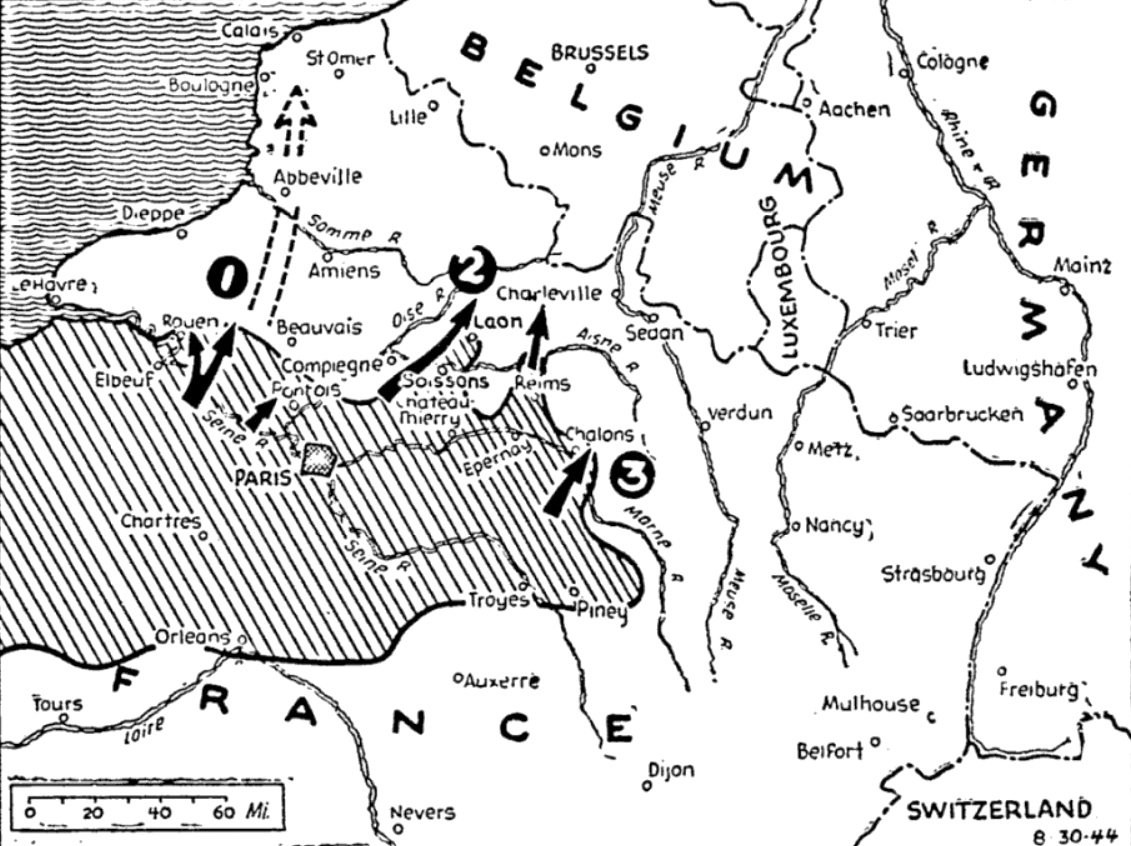The Pittsburgh Press (August 30, 1944)
Yanks beyond Reims in race for Belgium
Only scattered Nazis oppose U.S. push on German Rhineland
By Virgil Pinkley, United Press staff writer
Across the Aisne River, U.S. troops today drove toward the Belgian border, as Allied forces northwest of Paris linked their bridgeheads (1) for a drive toward the robot bomb coast and the Germans reported the evacuation of Rouen. In the drive across the Aisne, U.S. forces reached Laon (2), while to the east U.S. columns pushed beyond Reims and were within 90 miles of Germany (3).
SHAEF, London, England –
Two U.S. tank armies, racing unchallenged over the last miles of the invasion roads to Germany and Belgium, stormed into Laon and the cathedral city of Reims today, while Berlin admitted that its troops had abandoned the medieval town of Rouen, guarding the robot bomb coast of northern France.
Powerful armored spearheads of the U.S. 1st and 3rd Armies punctured the Aisne River line on at least two points and were reported fanning out over the rolling farmlands beyond Reims, Laon and Châlons-sur-Marne.
Only scattered and disorganized Nazi rearguards barred the path of the American armor in their sweep for the Rhineland, and official reports indicated the Yanks were moving at a speech that could carry them to the Belgian border within a day or two.
Beyond Reims and Laon, U.S. spearheads were 30 to 35 miles from the borders of Belgium, while other U.S. columns pounding eastward from Châlons were 95 miles or less from Germany.
Planes plaster foe
“We are now witnessing the preliminary phase of the Allied advance on Germany in which the enemy forces are being methodically dissected and forced into isolated corridors, even as we press onward,” United Press writer Henry T. Gorrell said in reporting the sensational sweep of the U.S. armies through the Aisne and Marne Valleys.
U.S. riflemen poured swiftly through the breaches crated by their plunging tank spearheads, while swarms of Allied warplanes ranged before them to bomb and strafe the retreating enemy.
Simultaneously, British, U.S. and Canadian forces linked their bridgeheads across the Seine above Paris into a solid 50-mile front and swung forward 25 miles beyond the Seine to drive an armored wedge between Rouen and Beauvais.
Capture Neuf-Marché
The Allies, smashing directly at Amiens and the heart of the bases from which German robot bombs have been showering down on London, captured Neuf-Marché, 25 miles east of Rouen and 15 miles west of Beauvais.
There was no confirmation of the Berlin report that Rouen had been evacuated, and Allied headquarters said latest advices from the front told of bitter fighting on the approaches to that fortress town.
On the U.S. 1st and 3rd Army fronts east of Paris, however, official and enemy reports agreed that the twin American offensive was making spectacular strides over battlegrounds where hundreds of thousands of men fought and died in 1918 to take and hold a few yards along the Marne and Aisne Rivers.
Drive across Seine
Lt. Gen. George S. Patton’s 3rd Army tanks and riflemen drove across the Marne at Épernay, pushed 13 miles northward to Reims and then swept on more than 10 miles beyond that historic town to cross the Aisne at Neufchâtel.
Simultaneously, Lt. Gen. Courtney Hodges’ 1st Army veterans stormed up from captured Soissons, across the Chemin des Dames, one of the bloodiest battlefields of World War I, and on into Laon, 12 miles above the Aisne. Unofficial but apparently correct reports said Laon was captured and that the Yanks had driven on beyond the city.
The region between the Marne and the Aisne had been reported one of the stronger outer bastions guarding the invasion roads to Germany, but today’s sweeping progress indicated the enemy had abandoned it almost without a fight.
Sedan and the Ardennes Forest, through which the German armies poured in 1940 to collapse France, were wipe open to the American thrust northeast of Soissons, and the Argonne Forest, on the road to Alsace-Lorraine, was 25 miles or less from Gen. Patton’s spearheads beyond Châlons.
A German Transocean News Agency broadcast said the Americans had reached Saint-Dizier, 85 miles from the German border, but claimed they had been driven back by Nazi counterattacks.
Stiffer resistance was encountered in the Seine bridgehead area above Paris, however, and official reports said the Germans were fighting a stubborn rearguard action there.
Claim evacuation
A German communiqué announced that Nazi forces had evacuated Rouen, on the Seine 65 miles northwest of Paris, after destroying all harbor installations and “other objectives of military importance.”
The Germans apparently pulled out of Rouen, where Jeanne d’Arc was burned at the stake in the public market square May 30, 1431, to escape encirclement by Allied armies closing in from the south and east in a drive toward the robot coast.
The fall of Rouen was expected to speed the Allied march on Le Havre, 45 miles to the west, and Dieppe, 37 miles to the northwest.
Capture Longchamps
Another Allied column captured Longchamps, 20 miles north of the Seine and 47 miles from Amiens, so-called capital of the robot coast. British forces were believed spearheading the drive toward the robot platforms, spurred by the knowledge that the sooner they capture them, the sooner the rain of death on their families in southern England will cease.
London newspapers bannered reports that massed Allied tanks were converging on the robot bases, including some from which the Germans were reported preparing to hurl rockets each containing 10 to 20 tons of explosive against Britain.
Front dispatches disclosed that Gen. Hodges’ U.S. 1st Army had taken over the drive northward toward Belgium from Gen. Patton’s 3rd Army.
After capturing Château-Thierry, Soissons, Belleau Wood and other hallowed ground over which their fathers fought and died in World War I, Gen. Hodges’ forces poured across the Aisne River in great strength and stabbed northward to Laon, four-way railway junction 19 miles above Soissons, and 28 miles northwest of Reims.
Both Laon and Reims lie on the main trunk line running west from Amiens over which the Germans have been moving a major proportion of their robot bomb components from factories in the Rhineland.
Gen. Patton’s forces smashed across the Marne at Châlons and captured Lépine, 4½ miles to the east and a little more than 50 miles southwest of Verdun. Marson, eight miles southeast of Châlons, also fell, bringing Gen. Patton’s men approximately 90 miles from the borders of Germany itself.
Broadens wedge
Broadening his wedge aimed at Germany, Gen. Patton likewise seized Vitry-le-François, 18½ miles southeast of Châlons, and Piney, 15 miles east of Troyes.
U.S. infantry also cleared virtually all areas in and around northwest, north and northeast of Paris and advanced to within a mile of Pontoise, 18 miles northwest of the capital.
U.S. forces drove 13 miles north from their Mantes crossing 25 miles northwest of Paris and reached Magny-en-Vexin.
Capture Éragny
Other Allied troops captured Éragny, 25 miles northwest of Mantes.
Only two small loops south of the Seine now remained to be mopped up.
Allied headquarters announced that 92,000 Germans had been captured in northern France by the Allies from Aug. 10 to 25, while a field dispatch estimated German losses in killed, wounded and prisoners since D-Day at upwards of 250,000 men.




